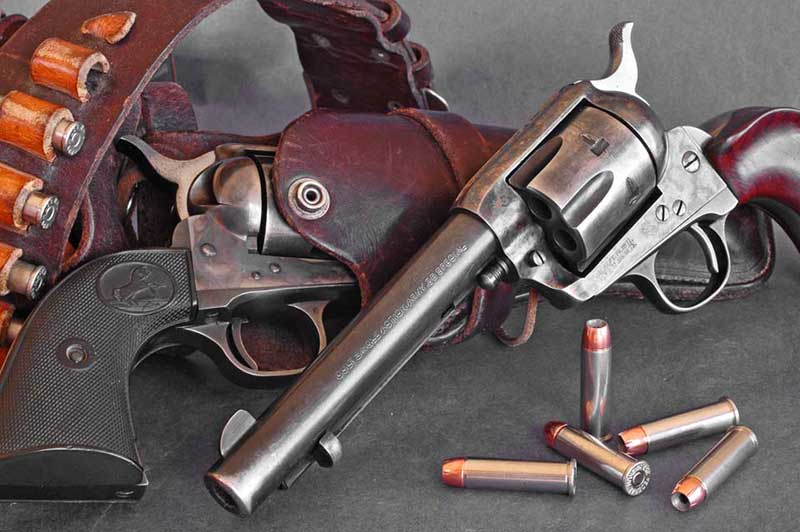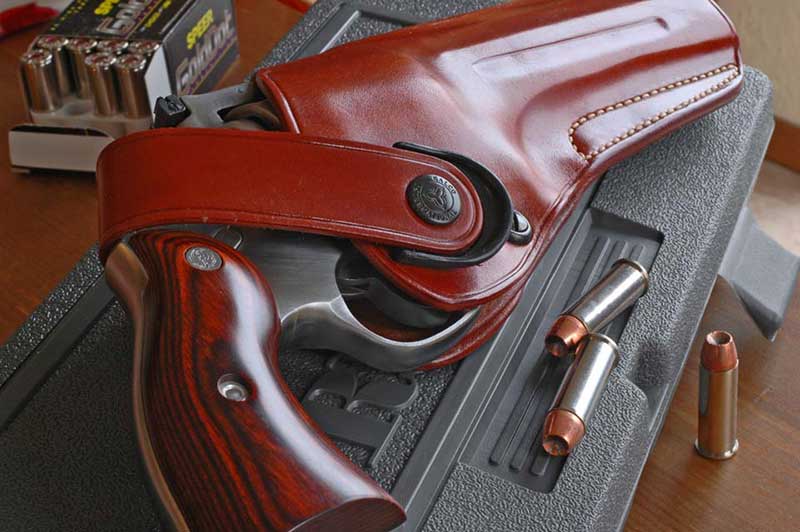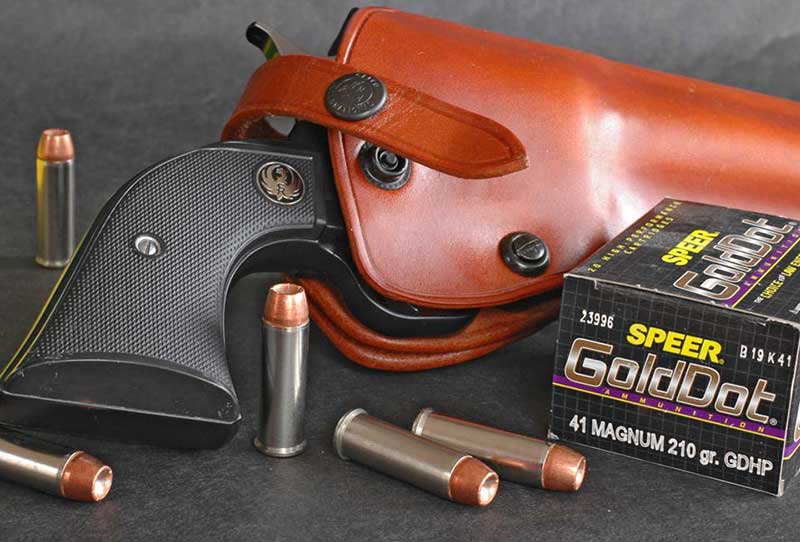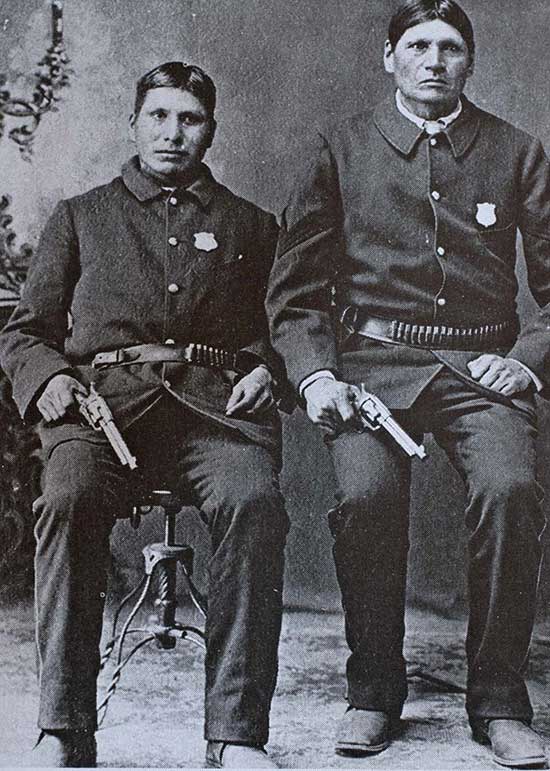Gunleather
They Didn’t Wear Polymer In The Old Days …
Marty Robbins could have written Texas Red hadn’t cleared his Kydex before the handsome ranger with a Big Iron on his hip dropped him in the street at twenty past eleven. Marty knew better …
Like walnut, bourbon and a handful of other things yet to be overtaken by substitutes, leather has enduring appeal. Besides its obvious place in holsters, it’s the first-round pick for belts, boots and bridles, saddles, slings, sheaths and scabbards. If you predate color television, you may recall leather scope caps and lace-on cheek-pieces for rifles and leather-looped panniers on sawbucks secured by leather rigging to the lathered backs of mules plodding up mountain steeps.
Those of us who shoot rifles competitively even dress in leather. While you can fire match-winning pistol scores in a T-shirt, a leather coat helps you steady a free-rifle or a prone gun. As a bankrupt college student, I saved a few dollars by buying one from a chap twice my girth and half my height. I never got the support a leather jacket affords when properly fitted. Leather begs to become personal; in sling or coat it remembers your shooting positions — as a belt, it automatically wraps your waist and in a billfold, molds to your butt.
Skin In The Game
Holsters may not be the reason cattle have skin, but a better explanation eludes me. Leather is still, arguably, the best holster material around. It can be made stiff or supple, cut to fit any pistol closely and then molded quickly to shape by the weight and profile of the gun itself. Durable and protective, it has a rough inner surface able to grip the steel with just the right amount of friction. The hard, finished side of polished leather is handsome, slips easily against clothing and sheds water like glass. But even before handguns, leather had its uses.
Leather dates to the third chapter in Genesis: “The Lord God made garments of skin for Adam and his wife and clothed them.” Evidence of the earliest human life includes hide-scraping tools from Spanish caves. Because leather has been around so long, people have figured out how to transform it from skin to commodity, to make it pliable and finish it stiff and to give it rough and slick surfaces. They’ve learned to sew, mold, color and marry it with other materials. They’ve perfected ways to preserve and renew it — even keeping its distinctive smell.
By the time a slab of animal skin becomes a piece of leather it endures brutal treatment. It’s first done with caustic salts, which leave it hard as a sheet of plywood. In wet-salting, hides are stacked as a multi-layer salt sandwich and given a month or so to cure (brine solution acts more quickly). Dumped into vats containing disinfectant and brine, the skins reach salt saturation in about 16 hours. Soaking in water removes the salt and blood. Immersion in lime solution, with a pinch of sodium sulfide, loosens hair for a mechanical de-hairing machine. The skin is then scraped, died, stretched, sandpapered and treated with heavy metals. It looks and smells like sun-baked road kill. De-liming follows, in an acid solution used to reduce the swelling caused by the lime and is often augmented with “bating” enzymes to render the skin soft and flexible.
Tanning stops decay and prevents shrinkage. The two most common tanning processes are vegetable and chromium. Vegetable tanning typically requires weeks or months. It produces firm, stretch-resistant leather — it’s also water-repellant. Chrome tanning can be done in a day, shrinking the material to make it longwearing and resistant to heat. Leather can be tanned by both processes, with the chrome treatment first to impart specific properties.
Vegetable tanning is named so for the tannins used. Chestnut wood is a popular source of tannins in the US. The same goes for the bark of oak and hemlock — though fibers from foreign plants account for 80 percent of the domestic supply. After bating, the hides move through a series of rocking frames and progressively stronger tanning solutions, called liquors. Weeks later, the process ends in vats of very stout liquors. Heat may be applied to speed up this step. Lightweight leather receives less tanning time compared to thicker materials.
Chrome tanning begins in a solution of salt and acid, which pickles the bated skins. They then go to a drum, which tumbles them in a basic chromium-sulfate solution. That’s it, albeit a longer process; two baths is used for some types of leather. Vegetable-tanned sole leather is bleached, and then immersed in Epsom salts, oils and glucose, and finally emulsions of soap, grease and sometimes wax. Finishing heavy leather includes a series of chemical and mechanical treatments. Splitting and shaving chrome-tanned leather reduces its thickness. Light leathers get buffed or sandpapered to erase imperfections. Rollers add firmness, providing a glossy finish. Waxes, shellacs, varnishes and emulsified resins (and glazing) also give leather a polished surface. Glossy patent leather results from several coats of oily varnish. Buffing the flesh side of leather raises the nap to produce suede.
Getting To The Gun
While most leather is a by-product of the meatpacking industry, skins from exotic creatures such as ostrich, kangaroo, alligator, even elephant and Cape buffalo, bring the highest prices. All appear in custom leather goods for shooters.
Some specialty products, like leather-covered recoil pads, require very thin material. Pigskin can be wrapped fully, front and back, as required. The stockmaker must carefully reduce pad dimensions, then stretch-fit and glue the skin. Screw holes must be plugged and the plugs covered too. It’s time-consuming, but leather adds a classy touch to any pad. It prolongs pad life and provides a perfect surface, with enough friction to stay on your shoulder, but not too much.
A new leather holster doesn’t know what to do with itself. You must train it to your firearm and body. It’s best to slide hardware into leather gingerly, until the material gets accustomed to it and then, like a shy teenager, decides hugging is okay. Even stiff leather is tractable; a day in the field cuddling your S&W will give the holster an affinity for it. A knife sheath needs more time to get familiar because knives are lighter … and sharp. An amigo once thrust his DiamondBlade knife through a chaste sheath when he joined them too quickly. You can wet new leather to help, but doing so is an unduly harsh introduction. As with bourbon, time improves results.
Here’s a caveat: Don’t leave firearms in leather. Even a knife is best stored separately, given possible salt and moisture residues in the leather. Also, vegetable-tanned leather turns brass cartridge hulls and belt hardware green with verdigris. This doesn’t affect nickel-plated metal.
Old, experienced leather, like the worn walnut of a vintage revolver, rifle or shotgun, deserves a modicum of care — and it adds both esthetic and market value to the gun. A tooled holster made long ago by a lawman for his 1917 Colt held onto it like a suitor would the palm of a maiden he wished to impress. I shouldn’t have ever traded that outfit away, and I no longer part with old leather — even my Latigo slings, which date to Ford’s first Mustang, and a Milt Sparks gun-belt, which has kept my pants up since bell-bottoms. The scabbard an Oregon saddlemaker made me has a permanent home, despite deep scars from the Eagle Cap, Bob Marshall and Frank Church.
Caring For Your Leather
Oddly enough, after decades of using leather, I’ve found little consensus from leather gurus about caring for it. Most advise keeping leather from warm, sunlit places — which can dry it out. Many also suggest hanging it where air can circulate to keep rot and mildew at bay. A fellow who’s manufactured Harley-Davidson saddlebags told me to “keep leather supple but not over-oiled. Air-dry wet leather slowly; direct heat can cause shrinking and cracking.”
A bootmaker advised brushing off dirt before it can penetrate and abrade. “Scrub leather with saddle soap on a damp cloth. Then wipe the lathered surface dry. Apply Neatsfoot oil or wax, depending on the leather.” DeSantis advises no dressing on its holsters, lest they become soft. For hard-finished leather, you can’t go wrong with properly-tinted shoe polish!
To be fair, not everyone likes leather. “When you carry a pistol in triple-digit temps,” a patrolman told me in Miami, “you need a lightweight holster so it doesn’t stick to your body.” He said sweat makes leather smell bad, and it’s not as easy to wash as polymer. Acids and moisture in leather cause handguns to rust; heat accelerates damage. Oil deters rust, but over time gun oil weakens a leather holster.
Injection-molded, thermoplastic Kydex — like hard nylon and Safariland’s polymer laminate — serve as well as leather for most jobs. Holsters like these can also be adjusted for tension. Blade-Tech is a popular brand; same with BLACKHAWK!’s SERPA. Hard synthetic material is a boon to officers exposed to blood-borne pathogens and chemicals splashed during drug raids. Another polymer plus includes a modular, quick-release belt hook-up for holsters, magazine pouches and accessories.
Movies And Makers
Leather’s rich history in the gun trade is largely responsible for its continued popularity. Polymer had no role at the O.K. Corral. Leather carried Hickock’s 1851 Colts, served William Bonney, the James Gang and Butch Cassidy. It also has a long affiliation with Hollywood, not just in early westerns, but also in movies like Dirty Harry and television shows like “Miami Vice”. Don Johnson’s shoulder holster on the series became as distinctive as its cinematography.
When the pilot aired in 1984, Galco had been making shoulder holsters for 14 years, 11 of those as The Original Jackass Leather Company in Chicago, where Founder Richard Gallagher built horsehide holsters for local police. Galco had been in Phoenix for just a year when Hollywood rang up for a holster to hide Johnson’s Bren Ten under his Armani suit. Rick Gallagher flew to Miami and the Jackass shoulder holster became the Miami Classic.
Though Galco holsters have often appeared onscreen, handgunners know them in less glamorous roles. The real function of a holster is to cradle a pistol securely and comfortably, then release it to the hand in an instant. Galco’s extensive line of leather, from pancake and Yaqui slide holsters to frontier belt and shoulder rigs, is distinctive for snug fit and beautiful finish. Fawn and oxblood remain alternatives to the black cataloged as the only color in competitive lines. In its custom shop, Galco fashions horsehide-lined holsters of alligator, shark and stingray.
Bianchi, another legendary name in leather, got its start nearly 50 years ago. John Bianchi, then a police officer in California, designed a duty holster to serve as a template for the firm’s 5BH and 19 models. Conflict in Vietnam inspired the X15 shoulder rig, followed by concealed and front-break belt holsters. In 1979, John founded the Bianchi Cup as his design team introduced “ballistic weave” nylon holsters. Five years later, Bianchi’s M12 became the first new holster for the US Armed Forces in nearly 70 years, replacing leather. Its leather Getaway and Path Blazer holsters for single-action competition feature hidden tension adjustments. Confidential and Assent belt models keep your 1911 close and comfortable, covering the muzzle.
I pair Don Hume belts and holsters with some of my S&W revolvers. The Oklahoma firm makes top-flight leather products. So does the Strong Leather Co. in Massachusetts, though its sales are largely to police. The holster house of Triple K began in a San Diego department store run by Herman Krasne and son Leo on the heels of WWII. When Leo’s son Jerry joined the business in 1952, he began selling sporting goods — later starting a new firm to make after-market magazines. Triple K Manufacturing Company (so named for his children, Kim, Kurt and Karen) grew its holster selection in the 1980s, then sold the retail business to tend catalog sales. Most Triple K products are still made in San Diego.
In Amityville, N.Y., DeSantis has cataloged an expanding selection of leather holsters since the early 1970s. It’s supplied U.S. Air Marshals, the FBI and the Secret Service. The current line boasts Kydex and nylon holsters as well as leather. Several belt models have triple slots to give you a choice of carry styles. The INNER PIECE, with or without over-hammer strap, has a stabilizing wing to prevent unwanted rotation. The TERMINATOR shoulder rig is among few made for S&W X-Frames.
Bianchi’s Wild Clearwater is one of the most appealing options for a 1911. It’s design and workmanship is first-rate. Like Galco and Bianchi, DeSantis also makes high-noon holsters for Peacemakers.
The best holster for your handgun keeps it secure as it keeps you comfortable. Unless you’re on a timer, staring down — or riding down — balloons, leather able to practically pop your pistol free at a touch is less useful than one that delivers a Super Bowl-sure handoff. After all, gun control matters, and you should have it as you lift your pistol from leather.
Subscribe To American Handgunner

Get More Carry Options content!
Sign up for the newsletter here:














